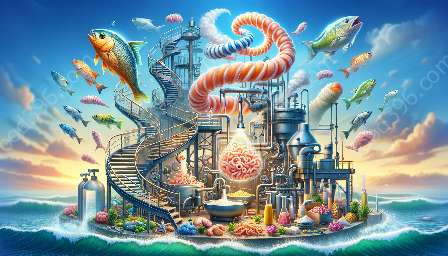Seafood by-products, often considered as waste, have the potential to be transformed into value-added products through innovative approaches and scientific advancements. This process is aligned with the goals of sustainable resource management, waste reduction, and the creation of higher value products from the seafood industry. The development of value-added products from seafood by-products is an essential aspect of seafood by-product utilization and waste management, while also playing a significant role in advancing seafood science.
Seafood By-Product Utilization and Waste Management
Utilization of seafood by-products and effective waste management are critical components of sustainable practices in the seafood industry. By transforming what was once considered waste into valuable products, the industry can significantly reduce environmental impact and improve resource efficiency. With the increasing global demand for seafood, it is imperative to maximize the utilization of all available resources and minimize waste generation.
There are various methods for seafood by-product utilization, including the extraction of high-value compounds such as proteins, peptides, lipids, and chitin from the by-products. These extracted components can then be utilized for the production of functional food ingredients, pharmaceuticals, nutraceuticals, and other high-value products. Furthermore, the utilization of by-products also contributes to the reduction of waste, lowering the environmental burden associated with the disposal of seafood processing by-products.
Value-Added Product Development
The development of value-added products from seafood by-products involves a multi-disciplinary approach that integrates principles of food science, biochemistry, and engineering. Through advanced processing techniques, such as enzymatic hydrolysis, extraction, and purification methods, various bioactive compounds and functional ingredients can be obtained from seafood by-products.
One example of value-added product development is the extraction of proteins from seafood processing by-products. These proteins can be utilized to formulate protein-rich food products, functional food ingredients, and supplements. Additionally, the extraction of chitin, a polysaccharide found in the exoskeleton of crustaceans, provides raw material for the production of chitin-derived products such as chitosan, a biopolymer with diverse applications in pharmaceuticals, agriculture, and food industries. These value-added products not only contribute to economic gains but also foster sustainable practices by utilizing the entire seafood resource.
Sustainable Practices and Innovation
The development of value-added products from seafood by-products aligns with the principles of sustainable practices and innovation in the seafood industry. By implementing efficient utilization of by-products and reducing waste, businesses can improve their environmental footprint while creating opportunities for new revenue streams. Furthermore, the utilization of advanced scientific methods and technology enables continuous innovation in the development of value-added products, contributing to the growth and advancement of seafood science.
It is essential for the seafood industry to embrace sustainable practices and invest in research and development focused on seafood by-product utilization. By doing so, the industry can contribute to the circular economy by minimizing waste and creating value from underutilized resources. The development of value-added products also presents opportunities for collaboration between academia, research institutions, and industry players, fostering a culture of innovation and knowledge exchange.
Conclusion
The development of value-added products from seafood by-products represents a significant opportunity for the seafood industry to enhance sustainability, minimize waste, and create high-value products. Through effective by-product utilization, waste reduction, and scientific innovation, the industry can make substantial strides towards sustainability and resource efficiency. It is crucial for stakeholders to continue investing in research and development initiatives that focus on maximizing the potential of seafood by-products, ultimately contributing to the advancement of seafood science and sustainable practices in the industry.

